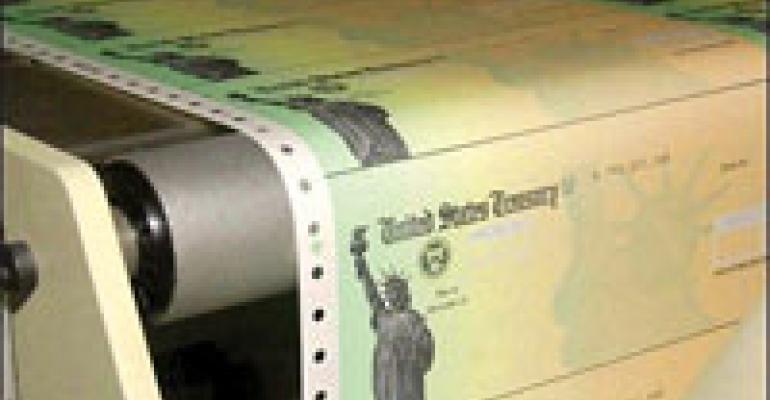
Good news if you’re hoping taxpayers will spend part of their upcoming $600-per-person windfall in your restaurant. That’s what they did the last time the federal government passed out rebates. To make sure you get your share this time around, you may want to adopt some of the practices followed in Alaska, where every citizen gets a rebate-like Permanent Fund dividend check every year. Restaurants and other businesses there are past masters at dealing with a customer base newly flush with a one-shot cash bonanza. It’s a skill you need right now.
Beginning this week, most U.S. taxpayers will receive checks for either $600 (single filers) or $1,200 (joint filers) as a rebate on their 2007 taxes. Officially, these sums are known as “Economic Stimulus Payments.”
But if you want to see an economy get stimulated, head to Alaska any spring and check out what goes on when every citizen there gets a dividend check from the state’s Permanent Fund. It comes from a pool of money—$37 billion right now—into which a portion of the state’s mineral revenues have been stockpiled against the day the oil runs out.
The amount of Alaska’s Permanent Fund dividend fluctuates from year to year. It was $845.76 in 2005, $1,654 in 2007. But whatever it is, merchants of all stripes, including restaurants, are ready to pounce when the cash hits. Car dealers, furniture stores and other dealers in big-ticket items have plenty of merchandise whose cost, or down payment amount, is exactly the same as the dividend fund check. Businesses with smaller-ticket items go with “spoil yourself just this once” offers set at, say, 10 percent of the dividend amount, while restaurants come up with special items and special menus where items cost just one percent of the dividend amount. If you just got a windfall of $1,654, a $16.54 entrée isn’t much of a splurge. It’s the same strategy every year, so you know it has to work.

But will it work for you? It did after the 2001 federal tax rebate, note the market research wizards at NPD Group. They say that restaurant visits increased approximately two percent for the six-month period after those rebate checks were mailed. Fast food feeders and casual dining restaurants were the segments that got the biggest boost then. That tracks with numbers provided by Deutsche Bank restaurant analyst Jason West. He cites figures that show restaurant sales spiked 3.2 percent in the period when 2001 rebate checks were released, compared to a 1.6 percent gain the previous year.
Even so, some of the biggest full-service restaurant chains don’t seem all that worked up about the opportunity. Here’s how Cheesecake Factory chief financial officer Michael Dixon handled a question about the rebate on the company’s most recent conference call.
“That’s the million dollar question. I think it’s difficult when we go back and look at those time periods to see what the real impact was,” he said. “All I can tell you is we certainly hope to get our fair share.”
Paul Avery, chief operator of OSI Restaurant Partners, told CNN he thinks some of the measures the company’s Outback Steakhouse has already put in place will help the chain attract more patrons when rebate checks begin to be cashed in May. He says customers have been spending less, and the OSI has begun to tailor its menu to meet those preferences. “They are ordering more appetizers, salads, side dishes and cutting back on alcoholic beverages,” he said. So the rebate period will be business as usual at OSI.
Darden’s Rich Jeffers said that his company had no plan to do any themed advertising or on-menu promotions tied to the rebate windfall. He noted, however, that Darden “had seen an uptick in discretionary spending in the past resulting from these rebates.”
These three casual dining giants hope to get a bump in revenue, but don’t seem to see rebate dollars as a meaningful opportunity to go after. Contrast that with the deals being rolled out by retailers, who are pursuing these dollars with vigor. Big grocery companies like Albertsons, Kroger and Supervalu will reward customers with a 10 percent ($30) bonus for every $300 store gift card they buy. Sears and Kmart will all give consumers a 10 percent premium when the whole check is cashed in for gift cards. Holiday Inn Sunspree “Vacation on the Government” package gives a couple a five-day vacation in Virginia Beach, VA, for exactly $1,200, breakfast and dinner included. Wal-Mart’s program to tap these funds started back in January.
So where are the deals from restaurants? A few large casual dining chains may be taking a pass, but other operators may look at this week’s tax rebates as a rare opportunity to boost sales and traffic, and perhaps encourage trial by new customers, in an otherwise-sluggish market. We think those who try to lure their temporarily flush customers base with menu options keyed to those $600 and $1,200 rebate amounts—a $6.00 starter, a $12 .00 entrée, a $60.00 dinner for two at an upscale restaurant—will get the boost they’re looking for. It’s a strategy that has worked over and over in Alaska since the first Permanent Fund dividend check—$1,000—was cut back in 1982.
Federal tax rebates began to show up in the bank accounts of e-filing taxpayers earlier this week. Paper checks mail on May 9. If you want to grab your share, you’d better get going now.





